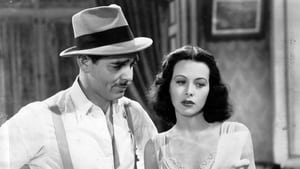Contact: info@alwanfilm.com
Video Sources 0 Views
- Watch trailer
- Comrade X 1940

Synopsis
Table of Contents
ToggleReview: Comrade X 1940 Colorized – A Timeless Political Comedy Illuminated in Vivid Color

Introduction
“Comrade X” (1940) stands as a brilliant blend of comedy and political satire, capturing the zeitgeist of its time with wit and charm. In this article, we’ll delve into the significance of this early colored film, exploring its impact on audiences and its lasting legacy in the realm of political comedy.
Check The Full Colorized Movies List
Check Our Colorized Movies Trailer Channel
Understanding Comrade X 1940 Colorized: Director, Cast, and Genre
Directed by King Vidor, “Comrade X” (1940) showcases his exceptional ability to craft films that resonate with audiences through humor and social commentary. The film stars the charismatic Clark Gable and the delightful Hedy Lamarr, whose chemistry brings a lively dynamic to the screen. Blending elements of comedy, romance, and political satire, “Comrade X” transports viewers to a world where humor is used to navigate and critique the complex political landscapes of the era.
Exploring the World of Comrade X 1940 Colorized: Plot and Characters
“Comrade X” (1940) follows the story of an American journalist, McKinley “Mac” Thompson (Clark Gable), who is stationed in the Soviet Union. Operating under the alias “Comrade X,” Mac sends uncensored reports about the regime back to America. His life takes an unexpected turn when his identity is threatened, and he becomes involved with a taxi driver, Theodore (Hedy Lamarr), who aspires to be a revolutionary. As they navigate the perilous political climate, their relationship evolves, blending humor with a critique of the sociopolitical environment.
The Art of Film Colorization
Film colorization serves as a transformative tool that enhances the visual experience of classic movies, breathing new life into timeless stories and captivating audiences with vibrant hues. By digitally adding color to black and white films, colorization allows viewers to immerse themselves in the rich tapestry of cinematic worlds, exploring every nuance and detail with fresh eyes and renewed appreciation.
Early Colored Films: A Brief History
The history of colored films traces its roots back to the early days of cinema, with filmmakers experimenting with various techniques to add color to their creations. From hand-tinted frames to early Technicolor processes, the evolution of colored film has been marked by innovation and ingenuity, paving the way for the development of modern colorization techniques that continue to captivate audiences to this day.
Comrade X 1940 and Its Early Colored Version
The decision to release “Comrade X” (1940) in a colorized format was met with both excitement and trepidation. While some welcomed the opportunity to experience the film in vibrant color, others expressed concerns about the potential impact on its visual aesthetic. Nevertheless, the early colored version of “Comrade X” (1940) offers viewers a fresh perspective on the timeless tale of love and political intrigue, enhancing its emotional resonance and captivating audiences with its luminous beauty.
The Debate Over Film Colorization
The debate over film colorization continues to divide audiences and critics alike, with proponents praising its ability to breathe new life into classic movies and introduce them to a new generation of viewers, while detractors argue that it compromises the artistic integrity of the original work and diminishes its historical significance. As the debate rages on, filmmakers and audiences alike are left to ponder the merits and drawbacks of colorization in the ever-evolving landscape of cinema.
Examining Comrade X 1940 as an Early Colored Film
As with any colorized classic, the impact of colorization on “Comrade X” (1940) is a matter of personal interpretation. Some may argue that it enhances the film’s visual appeal and immerses viewers in its world, while others may feel that it detracts from the stark beauty of the original black and white version. Regardless of one’s stance on the issue, there’s no denying the enduring power of “Comrade X” (1940) as a timeless political comedy that continues to capture the hearts of audiences around the world.
Influence and Legacy: Comrade X 1940 Colorized’s Impact on Cinema
“Comrade X” (1940) has left an indelible mark on the world of cinema, inspiring countless filmmakers and captivating audiences with its brilliant blend of humor and political satire. From its unforgettable performances to its clever commentary, the film continues to resonate with viewers of all ages, reaffirming its status as a beloved classic of the political comedy genre.
Director’s Cinematic Legacy: Beyond Comrade X 1940 Colorized
King Vidor’s influence extends far beyond “Comrade X” (1940), with a diverse body of work that continues to captivate audiences around the globe. From “The Big Parade” to “Duel in the Sun,” Vidor’s films are celebrated for their storytelling prowess and visual artistry, solidifying his legacy as one of the preeminent directors of Hollywood’s Golden Age. Through his groundbreaking work, Vidor has left an indelible imprint on the world of cinema, inspiring generations of filmmakers to follow in his footsteps.
Themes Explored in Comrade X 1940 Colorized
“Comrade X” (1940) explores a myriad of themes, from the transformative power of love to the intricacies of political satire. Through its richly drawn characters and sharp wit, the film invites viewers to ponder the complexities of political ideologies and the enduring strength of the human spirit. As audiences immerse themselves in the world of “Comrade X” (1940), they are reminded of the universal truths that bind us together and the enduring power of humor to illuminate even the darkest of times.
Reception and Controversy Surrounding Comrade X 1940 Colorized
Upon its release, “Comrade X” (1940) received widespread critical acclaim, with many praising its sharp wit, stellar performances, and insightful commentary on political climates. However, the decision to release the film in a colorized format sparked debate among purists, reigniting the age-old discussion surrounding film preservation and artistic integrity. Despite the controversy, “Comrade X” (1940) remains a beloved classic that continues to resonate with audiences of all ages, reaffirming its status as a timeless masterpiece of the political comedy genre.
Where to Watch Comrade X 1940 Colorized Online
For those eager to experience the timeless magic of “Comrade X” (1940), the film is readily available on popular streaming platforms such as Netflix, Amazon Prime, and Hulu. Whether you choose to watch it in its original black and white format or the early colored version, “Comrade X” (1940) promises to transport you to a world of humor and intrigue, where love and politics intertwine in the most unexpected ways.
FAQs About Comrade X 1940 Colorized
Q: Is “Comrade X” (1940) based on a true story? A: No, “Comrade X” (1940) is a fictional tale crafted by screenwriters Ben Hecht and Charles Lederer, who drew inspiration from contemporary political climates and societal observations.
Q: Who are the main actors in “Comrade X” (1940)? A: “Comrade X” (1940) features an ensemble cast led by the charismatic Clark Gable and the enchanting Hedy Lamarr. Their on-screen chemistry and dynamic performances bring the film’s characters to life, creating a memorable and engaging cinematic experience.
Q: What awards did “Comrade X” (1940) win? A: While “Comrade X” (1940) did not win any major awards, it received critical acclaim for its clever screenplay, stellar performances, and sharp political satire. The film’s enduring popularity speaks to its impact and legacy in the realm of political comedy.
Q: Why was “Comrade X” (1940) released in a colorized format? A: The decision to release “Comrade X” (1940) in color was made to introduce the film to a new generation of viewers and enhance its visual appeal for modern audiences. While the choice to colorize the film sparked debate among purists, it ultimately allowed “Comrade X” (1940) to reach a wider audience and ensure its continued relevance in the annals of cinematic history.
Q: How can I watch “Comrade X” (1940) in its original black and white format? A: “Comrade X” (1940) is available in its original black and white format on various streaming platforms and classic movie channels. Check services like Turner Classic Movies (TCM) or physical media options such as DVDs and Blu-rays to enjoy the film in its original visual glory.
Q: What makes “Comrade X” (1940) a timeless classic? A: “Comrade X” (1940) endures as a timeless classic due to its witty screenplay, charismatic performances, and insightful political satire. The film’s ability to blend humor with social commentary creates a compelling and entertaining narrative that continues to resonate with audiences across generations.
Q: Did “Comrade X” (1940) influence other political comedies? A: Yes, “Comrade X” (1940) has influenced many political comedies that followed. Its unique blend of humor and social commentary set a precedent for films that seek to entertain while also providing insightful critiques of political climates and societal norms.
Q: Are there other films similar to “Comrade X” (1940)? A: Fans of “Comrade X” (1940) may enjoy other classic political comedies such as “Ninotchka” (1939), “The Great Dictator” (1940), and “To Be or Not to Be” (1942). These films similarly blend humor with sharp social and political commentary, offering a compelling viewing experience.
Q: How does the colorized version of “Comrade X” (1940) compare to the original? A: The colorized version of “Comrade X” (1940) offers a fresh perspective on the film, enhancing its visual appeal and bringing new life to its vibrant characters and settings. However, some purists argue that the original black and white format better captures the film’s artistic intent and historical context.
Q: What is the significance of colorization in classic films like “Comrade X” (1940)? A: Colorization plays a significant role in reintroducing classic films to modern audiences, enhancing their visual appeal and ensuring their continued relevance. By adding color to timeless tales, filmmakers can create a more immersive and engaging viewing experience, while also sparking debates about the preservation and artistic integrity of original works.
Conclusion
“Comrade X” (1940) remains a timeless political comedy that continues to captivate audiences with its sharp wit, memorable performances, and insightful social commentary. Whether viewed in its original black and white format or the colorized version, the film offers a compelling exploration of love, politics, and the human spirit, leaving a lasting impression on all who experience its magic.
As we reflect on the enduring legacy of “Comrade X” (1940), let us celebrate its status as a beloved classic that transcends the boundaries of time and place. By embracing the film’s humor and wisdom, we are reminded of the universal truths that bind us together and the enduring power of cinema to inspire, entertain, and provoke thought.
So, whether you’re a seasoned cinephile or a casual moviegoer, take a moment to revisit “Comrade X” (1940) and experience the timeless magic of this political comedy. For in the laughter and lessons that unfold on screen, you’ll find a treasure trove of wisdom and wonder that will stay with you long after the credits roll.













